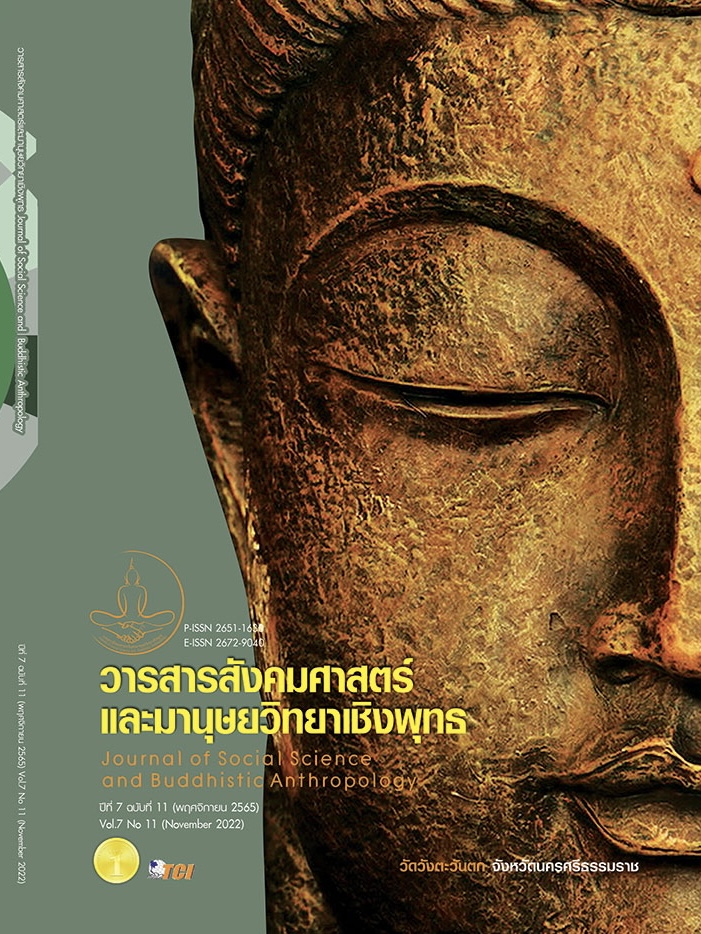DEVELOPMENT OF INTEGRATED SUPERVISION MODEL TO ENHANCE THE CLASSROOM RESEARCH COMPETENCY FOR PRIMARY SCHOOL TEARCHERS
Keywords:
Development, Supervision Model, Classroom Research Competence, Enhance the Classroom Research CompetencyAbstract
The objectives of this research article were 1) to examine the common dataset for development of the supervision model; 2) to construct and validate quality of the supervision model; 3) to explore the implementation of the supervision model; and 4) to evaluate the supervision model. The research consisted of 4 stages i.e. 1) examining the common dataset; 2) constructing and validating quality of the supervision model; 3) experimenting the supervision model; and 4) evaluating the supervision model. Experiments were carried out with 63 teachers, were selected by a specific selection, and the research instruments were: 1) Test of knowledge on classroom research; 2) Evaluation form assessing classroom research competency; 3) Evaluation form assessing classroom research report; 4) Attitude assessment towards classroom research; 5) Satisfaction questionnaire towards supervision model; 6) Opinion interview form for supervision. The data were analyzed for mean, standard deviation, dependent t-test. The interview data were analyzed by content analysis, frequency, percentage and narrative description. The results showed that: 1) The common dataset in constructing the supervision model indicated that integrating the advisory supervision, mentoring supervision, and clinic-oriented supervision in order to formulate the new supervision model were feasible and appropriate. This also extends HM King Rama 9’s working protocols namely “Understand, Access, Develop” principles and King Philosophy to underpin the educational supervision tasks. 2) The construction and validation of supervision model promoting classroom research indicated that the supervision model was rated at the highest appropriateness. The key components were principles, objectives, content, supervision procedure, assessment and evaluation. The supervision procedure constituted 5 stages. D1: Define problem and needs; D2: Direction Planning; D3: Development activities; E: Examine and evaluate; and P: Publish a successful work. 3) The experiment of the supervision model promoting classroom research indicated that, after the supervision, teachers acquired classroom research knowledge, showed classroom research competence, and held good attitudes towards classroom research higher than those of before the supervision at the significance level of .01. 4) The evaluation of the supervision model promoting classroom research indicated that teachers rated their satisfaction towards the supervision model at the highest level.
References
กรองทอง จิรเดชากุล. (2550). คู่มือการนิเทศภายในโรงเรียน. กรุงเทพมหานคร: ธารอักษร.
กระทรวงศึกษาธิการ. (2561). พระราชบัญญัติการศึกษาแห่งชาติ พ.ศ. 2542 และที่แก้ไขเพิ่มเติม (ฉบับที่ 2) พ.ศ. 2545 พร้อมกฎกระทรวงที่เกี่ยวข้องและพระราชบัญญัติการศึกษาภาคบังคับ พ.ศ. 2545. กรุงเทพมหานคร: องค์การรับส่งสินค้าและพัสดุภัณฑ์ (ร.ส.พ.).
กิตติ บุญปรุง. (2560). การพัฒนาแนวทางการนิเทศแบบสอนแนะสำหรับครูคณิตศาสตร์ของสถานศึกษาสังกัดสำนักงานเขตพื้นที่การศึกษามัธยมศึกษา เขต 21. ใน วิทยานิพนธ์การศึกษามหาบัณฑิต สาขาวิชาการบริหารการศึกษา. มหาวิทยาลัยมหาสารคาม.
ชาคริยา ชายเกลี้ยง และคณะ. (2562). รูปแบบการนิเทศแบบผสมผสานเพื่อส่งเสริมสมรรถนะการวิจัยของครูระดับมัธยมศึกษา. วารสารมหาจุฬานาครทรรศน์, 6(1), 5345-5361.
นัยนา ฉายวงค์. (2560). รูปแบบการนิเทศตามแนวคิดการเรียนรู้แบบผสมผสาน เพื่อเสริมสร้างความสามารถด้านการวิจัยในชั้นเรียน ของครูสำนักงานเขตพื้นที่การศึกษานครพนม เขต 1. ใน ดุษฎีนิพนธ์การศึกษาดุษฎีบัณฑิต สาขาวิชาหลักสูตรและการสอน. มหาวิทยาลัยราชภัฏสกลนคร.
ยุพิน ยืนยง. (2553). การพัฒนารูปแบบการนิเทศแบบหลากหลายวิธีการเพื่อส่งเสริมสมรรถภาพการวิจัยในชั้นเรียนของครู เขตการศึกษา 5 อัครสังฆมณฑล. ใน ดุษฎีนิพนธ์การศึกษาดุษฎีบัณฑิต สาขาหลักสูตรและการสอน. มหาวิทยาลัยศิลปากร.
ระย้า คงขาว. (2557). การพัฒนารูปแบบการนิเทศเพื่อเสริมสมรรถภาพการวิจัยเพื่อพัฒนาการเรียนรู้ สำหรับครูผู้สอนระดับการศึกษาขั้นพื้นฐาน. ใน ดุษฎีนิพนธ์การศึกษาดุษฎีบัณฑิต สาขาหลักสูตรและการสอน. มหาวิทยาลัยนเรศวร.
วัชรา เล่าเรียนดี. (2550). การนิเทศการสอน. นครปฐม: ภาควิชาหลักสูตรและวิธีสอนมหาวิทยาลัยศิลปากร.
วิจารณ์ พานิช. (2555). วิถีสร้างการเรียนรู้เพื่อศิษย์ในศตวรรษที่ 21. กรุงเทพมหานคร: มูลนิธิสดศรี-สฤษดิ์วงศ์.
สงัด อุทรานันท์. (2538). พื้นฐานและหลักการพัฒนาหลักสูตร. กรุงเทพมหานคร: วงเดือนการพิมพ์.
สำนักงานเลขาธิการสภาการศึกษา กระทรวงศึกษาธิการ. (2552). ข้อเสนอการปฏิรูปการศึกษาในทศวรรษที่สอง 2552 - 2561. กรุงเทพมหานคร: สำนักงานเลขาธิการสภาพการศึกษา กระทรวงศึกษาธิการ.
อัญชลี ธรรมะวิธีกุล. (2552). กระบวนการนิเทศภายใน. กรุงเทพมหานคร: อักษรบริการ.
อานนท์ ศักดิ์วรวิชญ์. (2560). เข้าใจ เข้าถึง พัฒนา: วิธีการแห่งศาสตร์พระราชาเพื่อการพัฒนาที่ยั่งยืน. เรียกใช้เมื่อ 3 มิถุนายน 2565 จาก https://mgronline.com/daily /detail/9600000103010
Joyce, B. R. & Showers, B. (2002). Student achievement through staff development. Alexandria. VA: Association for Supervision and Curriculum Development.
Downloads
Published
How to Cite
Issue
Section
License
Copyright (c) 2022 Journal of Social Science and Buddhistic Anthropology

This work is licensed under a Creative Commons Attribution-NonCommercial-NoDerivatives 4.0 International License.








